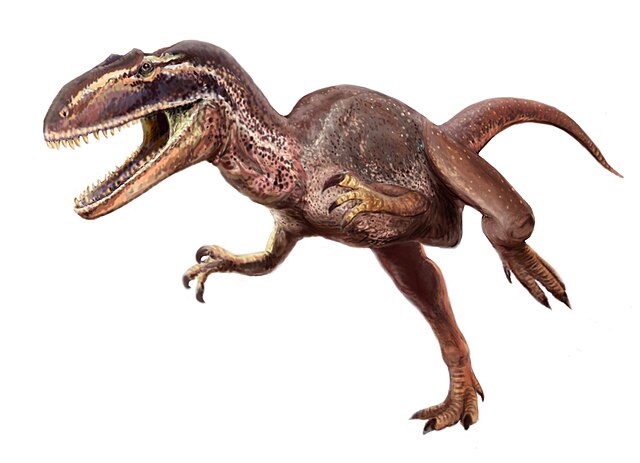Metriacanthosaurus (meaning "moderately-spined lizard") is a genus of metriacanthosaurid dinosaur from the Kimmeridge Clay Formation and Oxford Clay Formation of England, dating to the Late Jurassic period, about 160 million years ago (lower Oxfordian).
| Metriacanthosaurus | |
|---|---|
 | |
| Part of the holotype of Metriacanthosaurus parkeri (individual fossils not to scale) | |
| Scientific classification | |
| Domain: | Eukaryota |
| Kingdom: | Animalia |
| Phylum: | Chordata |
| Clade: | Dinosauria |
| Clade: | Saurischia |
| Clade: | Theropoda |
| Family: | †Metriacanthosauridae |
| Subfamily: | †Metriacanthosaurinae |
| Genus: | †Metriacanthosaurus Walker, 1964 |
| Type species | |
| †Megalosaurus parkeri von Huene, 1923 | |
| Synonyms | |
| |
History of discovery
The holotype of Metriacanthosaurus parkeri, specimen OUM J.12144, was discovered in 1871 by W. Parker at Jordan's Cliff, Weymouth,[1] and the specimen includes an incomplete hip, a leg bone, and part of a backbone; the geologist John Phillips briefly commented on the specimen during the same year.[2] These bones were from the Oxford Clay Formation, which dates to the Upper Jurassic.[3]
In 1923, German paleontologist Friedrich von Huene wrote a paper on Jurassic and Cretaceous European carnivorous dinosaurs within Saurischia. In this paper, he examined OUM J.12144, assigning it to a new species of Megalosaurus: Megalosaurus parkeri.[1] The specific name honours W. Parker. In 1932, however, von Huene concluded it was a species of Altispinax, A. parkeri.[4]
In 1964, scientist Alick Walker decided these fossils were too different from Altispinax, as they lacked the long vertebral spines, and named the new genus Metriacanthosaurus.[5] The generic name is derived from Greek metrikos, "moderate", and akantha, "spine". Metriacanthosaurus thus gets its name from its vertebrae, which are taller than typical carnosaurs, like Allosaurus, but lower than other high-spined dinosaurs like Acrocanthosaurus.
Description

Metriacanthosaurus was a medium-sized theropod with a femur length of 80 cm (31 in). Gregory S. Paul in 1988 estimated its weight at 1 tonne (1.1 short tons).[6] Thomas Holtz gave a length of 8 meters (26.2 feet).[7] Metriacanthosaurus was named for the height of its neural spines, which are actually not overly tall for theropods.[3] They are similar to other theropods such as Megalosaurus, Sinraptor, and Ceratosaurus in being 1.5 times the height of the centrum.[8]
Classification
Originally named as a species of Megalosaurus in Megalosauridae, Metriacanthosaurus has since been reclassified in Metriacanthosauridae. It is thought to be related to genera such as Yangchuanosaurus, and in 1988 Paul synonymized the two genera. However, a 2007 review of British dinosaurs by Darren Naish and David Martill defending keeping the two genera taxonomically separate.[3] Metriacanthosaurus is considered a member of the subfamily Metriacanthosaurinae.[9]
Below is a simplified cladogram of Tetanurae by Matthew Carrano et al. (2012).[9]
References
Wikiwand in your browser!
Seamless Wikipedia browsing. On steroids.
Every time you click a link to Wikipedia, Wiktionary or Wikiquote in your browser's search results, it will show the modern Wikiwand interface.
Wikiwand extension is a five stars, simple, with minimum permission required to keep your browsing private, safe and transparent.


